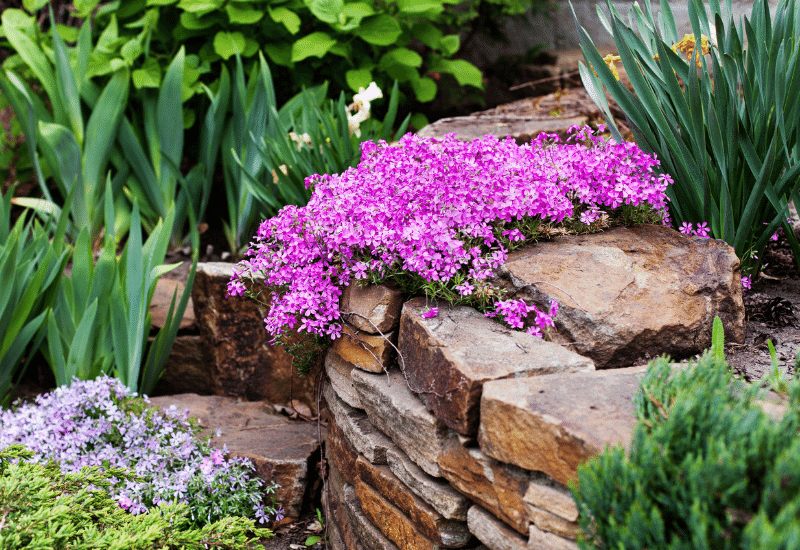
Turn your garden into a blanket of purple flowers with low growing, creeping ground cover plants. Also known as the color of royalty, purple flowering groundcovers brighten up your landscape and give your garden some beautiful hues to dive in.
Also known as the color of royalty, purple flowering groundcovers brighten up your landscape and give your garden some beautiful hues to dive in.
Some will grow in your sunny spots, like creeping phlox, others will bring vibrancy in the shade of trees, like periwinkle, and there are even evergreen varieties.
This way, when the blooms are spent, you will still have a relaxing and attractive green carpet to make your land look florid from spring to fall or even all year round!
To add a splash of color to the landscape year-round, pick hardy and evergreen perennials with low-maintenance, high impact blooms of the many shades of the purple range, from pale lilac to burgundy via violet.
You can grow them to cover large or small areas of bare land, but also to edge pathways, flower beds and borders, decorate rock gardens or grow between stepping stones.
Curious about the choices? I’ve put together a list of 15 of my favorite purple-flowering ground covers that promise year-round allure without demanding constant attention.
Dive in and let the purple reign in your garden!
Why You Should Choose Ground Cover Plants with Purple Flowers
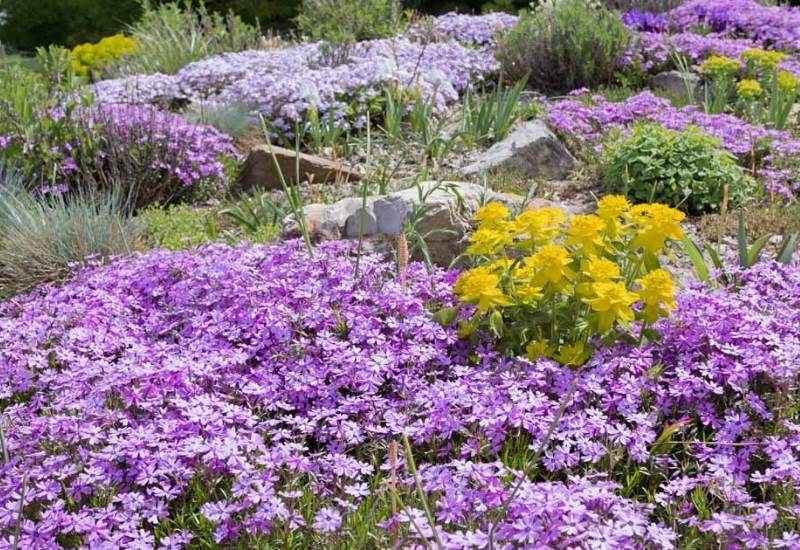
The first reason why I grow ground cover plants with purple blooms is the energy and vibrancy of this color.
It is a very spiritual and uplifting range, with pale, pastel shades like lavender and light mauve, all the way to raspberry and imperial purple, which are rich, strong and bright. This way, you can suit any palette.
Purple is also a color you can have in abundance from spring to fall, unlike other colors like red, which is rare in spring. This means that you can harmonize your color scheme throughout the seasons.
Why You Should Grow Ground Cover Plants
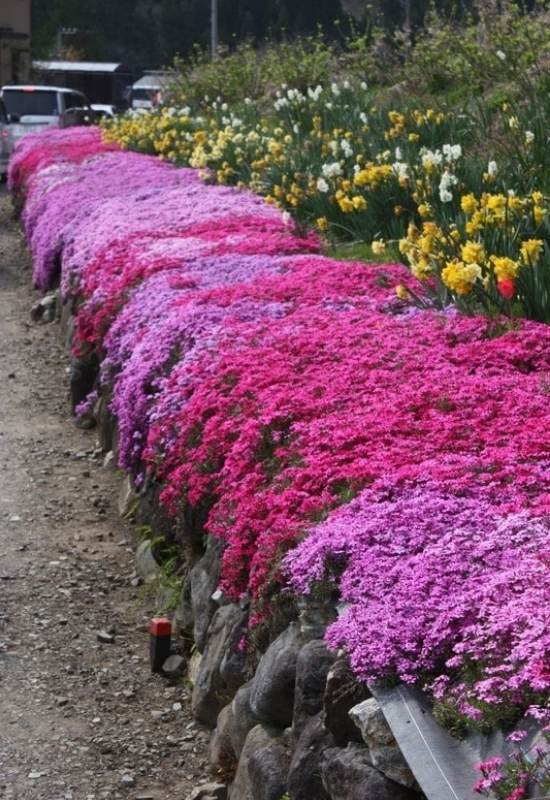
The first reason to grow ground cover plants is that exposed soil does not look attractive, and if you add some purple, the change will be really impressive. But there are many more.
Creeping and covering plants keep soil moisture and they preserve nutrients within it. They are, in a way, like mulching, but more attractive!
Most plants in our list and most ground cover plants in general are low or even very low maintenance; this means that you will cut down the time you put into your garden, but still you will have a great display for your guests – and yourself of course!
Finally, ground cover plants also tend to spread fast and they are cheap. You don’t need to fully cover the area you choose, plant them in a scattered fashion and they will soon do all the work for you – and save you money in the process.
So, off we go!
15 Great Ground Cover Plants with Purple Flowers
The array of purple shades lends a serene yet majestic aura to the landscape. Here are 15 wonderful ground cover plants with purple blooms to consider:
1. Periwinkle (Vinca minor)
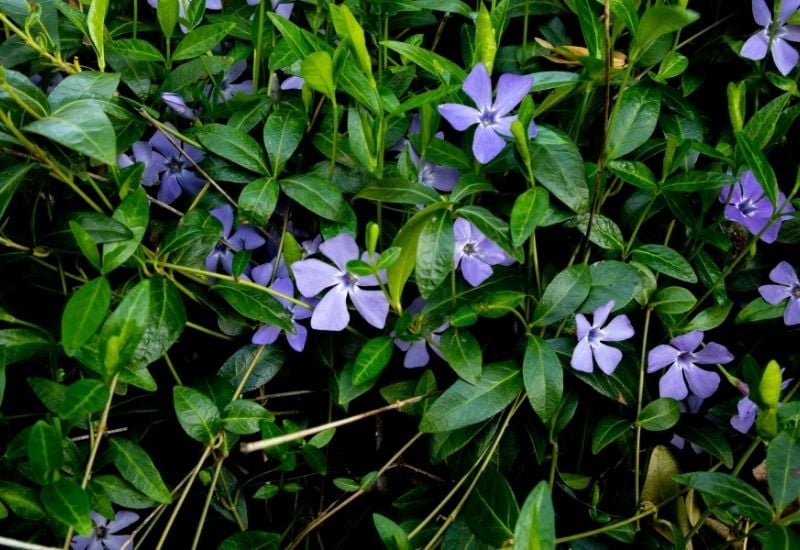
Periwinkle is a gracious and evergreen ground cover plant with lavender colored blooms. With their iconic whirling petals with flat tips, they look very much like little fans.
Excellent because it spreads fast and suppresses weeds, it grows well in virtually all light conditions, including full shade. For this reason, it is an ideal choice for all garden conditions.
There are many varieties, like major periwinkle (Vinca major) with larger flowers (1.5 inches or 4 cm) and the smaller but hardier lesser periwinkle (Vinca minor) which grows spontaneous in most temperate regions.
The foliage is elliptical, dark green and hard, and it grows on arching stems. There are also variegated varieties, with yellow and green leaves.
Periwinkle is a safe choice for ground cover; it will propagate with stolons and keep your garden looking lively all year round. Excellent for most informal settings and also in rock gardens.
2. Creeping Thyme (Thymus serpillum)
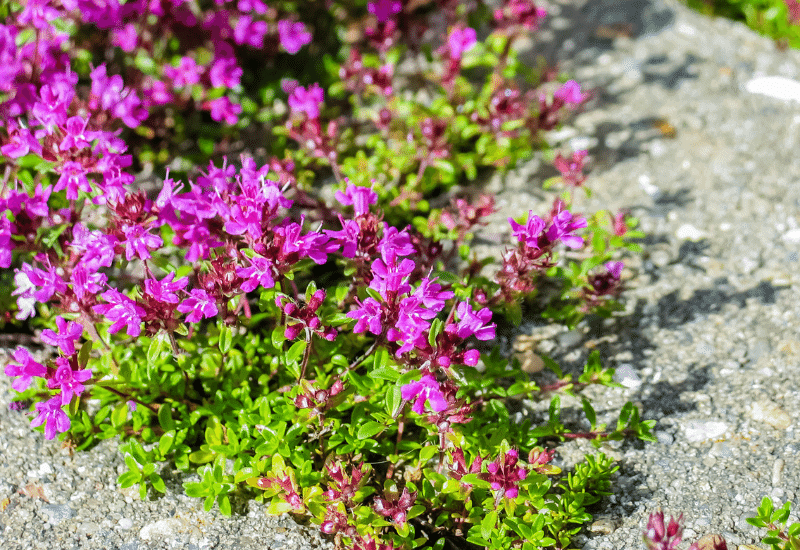
Creeping thyme is one of the most common full-Sun ground cover plants ever, and it has flowers in a wide range of purple shades, from pale lilac to raspberry, depending on the variety and cultivar.
It will literally turn into a sea of color, because the little but dense blooms will totally cover this small shrub. It forms tiny and cushion shaped little bushes that have aromatic leaves as well.
And this little beauty too is evergreen, so, after the summer blossom display, you will have your land covered in a thinly textured carpet of green foliage.
It is also a real magnet for pollinators and butterflies, because it is very rich in nectar, and this too adds to the effect.
Creeping thyme is a very low growing plant, which makes it ideal for stepping stones, rock gardens, and places close to your house, like on the sides of pathways. Perfect for coastal gardens, it is only suitable to sunny spots though.
3. Creeping Phlox ‘Violet Pinwheels’ (‘Phlox ‘Violet Pinwheels’)
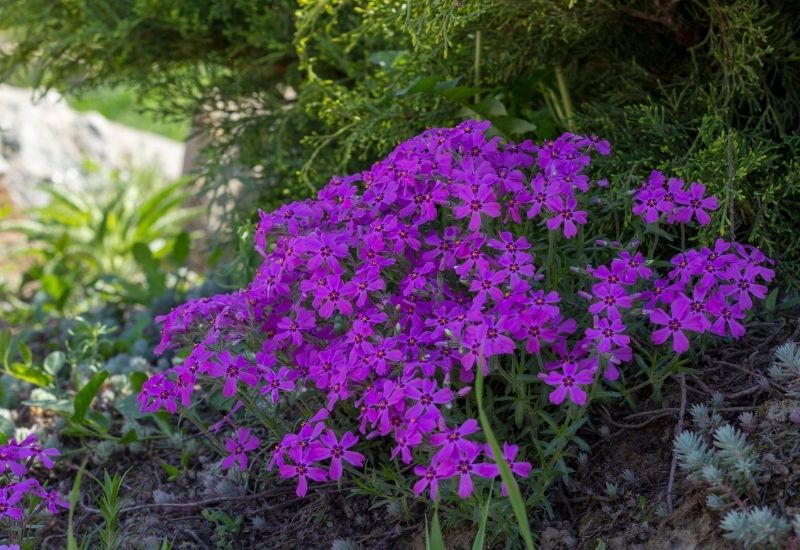
Creeping phlox ‘Violet Pinwheels’ is excellent if you want some unusual qualities from your ground cover. To start with, it has the most vibrant shade of violet purple ever – almost electric and very full of energy.
The flowers are star shaped, and it will produce so many that you won’t be able to see the foliage at all when in bloom.
This massive display also occurs much earlier than other creeping phlox varieties, so you can have this purple spectacle in spring. After this show, you will still be able to enjoy that dark green, needle shaped leaves that will cover your soil till fall.
Creeping phlox ‘Violet Pinwheels’ is perfect if you want a strong and super vibrant effect. It is small enough to fit into rock gardens and flower beds. It is ideal for a sudden flush of color that starts very early in spring, to bring your garden back to life.
4. ‘Birch Hybrid’ Bellflower (Campanula ‘Birch Hybrid’)
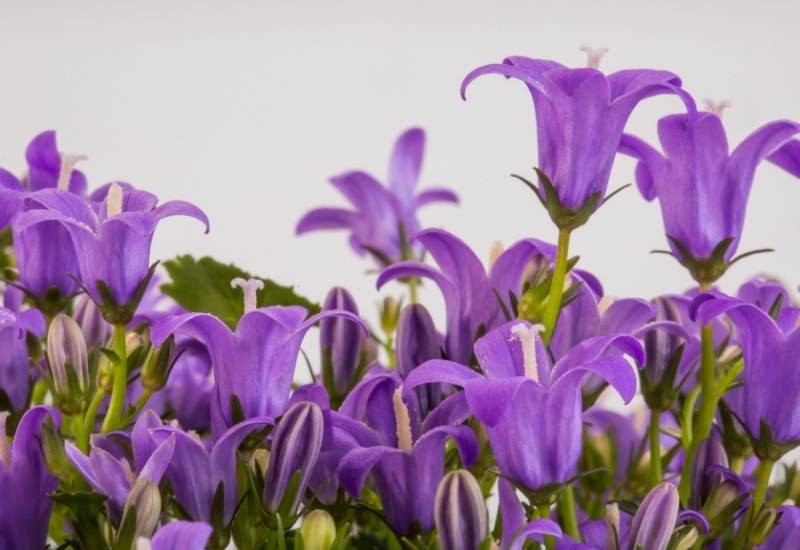
‘Birch Hybrid’ is a a very low and spreading purple bellflower, which makes it perfect for ground cover. It is very vigorous and it spreads naturally and fast, and it is excellent for a late season burst of color and beauty.
In fact, the bell shaped flowers will appear in early summer but they will stay on through fall. And the shade of violet they have is very intense and eye catching.
The blooms are not just long, but also quite dense. They perfectly match the dark green, broad, almost cordate (heart shaped) leaves with gentle spiny edges. And you will enjoy them all year round, because this plant too is evergreen!
In full sun or more shady spots, ‘Birch Hybrid’ bellflower is a wonderful ground cover plant for all informal gardens; the blooms are quite showy and so it also works well for flower beds and rock gardens.
5. Carpet Bugleweed (Ajuga reptans)
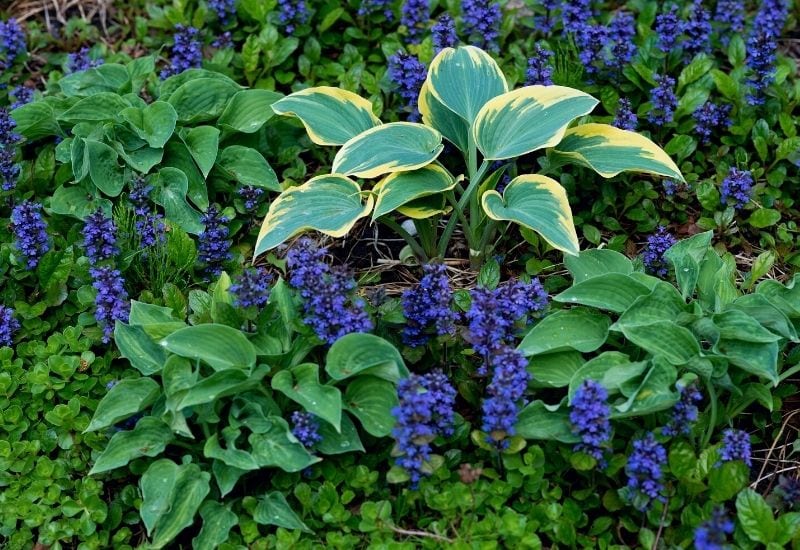
Carpet bugleweed fast-growing and shade-loving groundcover, which will quickly covers ground with its dense violet purple blooms. They appear in upright spikes of packed lavender shaped flower heads, small when seen individually, but the overall effect is impossible to miss.
This show will occur very early on in the season, then you will keep the foliage as a decorative blanket all year round, as it is evergreen.
There are a few varieties, with different shades that range from lavender to amethyst, as well as some blue cultivars. Finally, you can choose the variegated ‘Burgundy Glow’ with pale cream yellow and light silver green leaves, or ‘Black Scallop’, with very dark purple foliage.
Carpet bugleweed is ideal if you have difficult soil conditions, like very sandy soil. It tolerates shade as well. You can also transplant it into containers and on slopes.
6. ‘Celeste’ Lithodora (Lithodora diffusa ‘Celeste’)
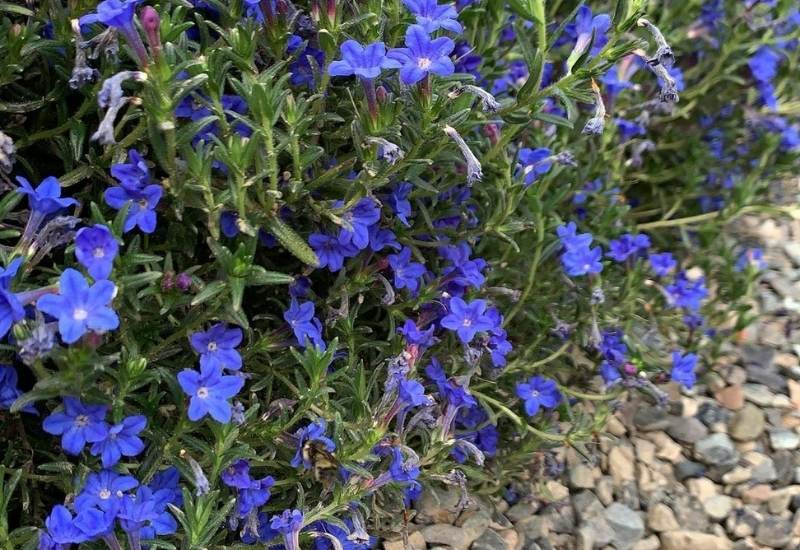
Lithodora is a mat forming evergreen shrub which makes it excellent for ground cover.
Most varieties are in the blue range, but ‘Celeste’ has lovely pure purple flowers, quite vibrant and very profuse.
The blooms are star shaped and have five petals, very well proportioned and they are slightly cupped.
They are small, but they are still fairly showy and attractive, coming just in top of the green cushion of the foliage.
The evergreen leaves are bright green in color, thin and long and arranged in rosettes on the stems; this gives you a very fine texture and lovely light effects.
This spreading shrub forms lovely cushions that will keep weeds off and protect the soil.
‘Celeste’ lithodora is ideal for informal gardens, edging, rock gardens and even on the sides of pathways. But you can have it in containers too, and propagating it is very easy.
7. ‘Queen Charlotte’ Sweet Violet (Viola odorata ‘Queen Charlotte’)
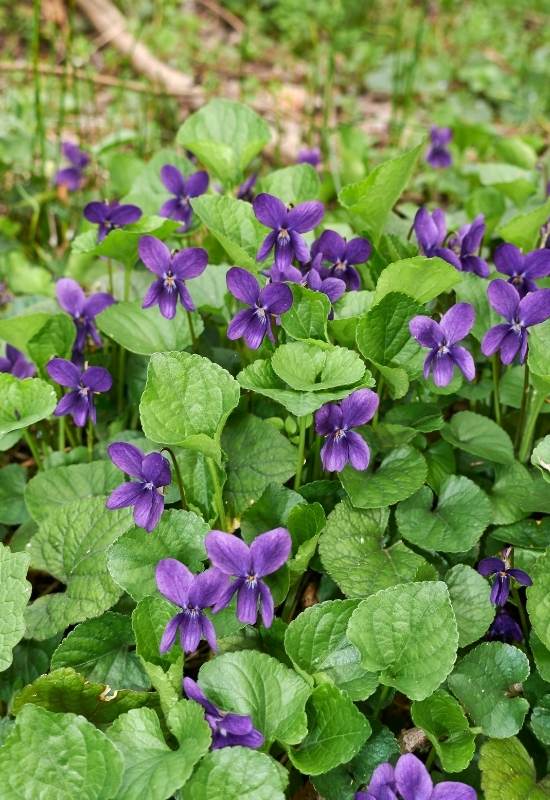
Many violets have purple flowers, in fact one of the most impressive ranges, and they are all great as ground cover, but we selected ‘Queen Charlotte’ for a few reasons. To start with its color is very vibrant, very strong and intense, in fact, a perfect “purple 3” hue.
There are lines with some elegant fading and veins towards the center, where it displays a golden center that draws your eyes in. But there is another reason, this is a Viola odorata variety, which means that it has fragrant blooms.
The cordate (heart shaped) leaves are mid green and bright, like those of other varieties, and they will stay on through winter because it is evergreen.
‘Queen Charlotte’ sweet violet is an heirloom cultivar introduced in 1900; it gives you the extra touch compared with other varieties, and you can grow it to have this amazing color when there is little going on in your garden, as it blooms even in spring.
8. ‘Darley Dale’ Winter Heath (Erica x darleyensis ‘Darley Dale’)
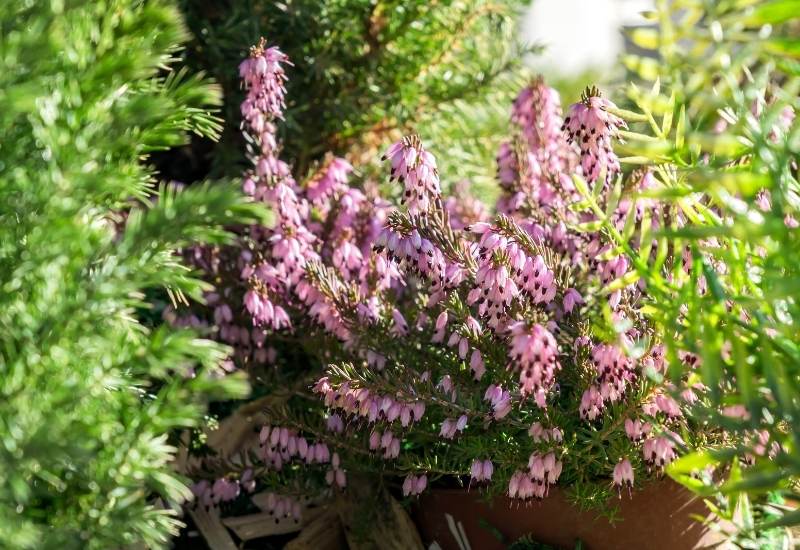
‘Darley Dale’ winter heath one of the best varieties of heather for ground cover if you want a sea of purple.
Other varieties will have less decides shades, but our pick has a perfect bright and vivid deep mauve hue like no other.
Famous for its impressive winter blooms, this low shrub will literally cover in a myriad small flowers even when it snows! Strong and low maintenance, it will keep weeds away and replace them with thick and decorative needle shaped leaves of the brightest mid to dark green shades.
‘Darley Dale’ winter heather is the perfect solution if you have difficult soils, like acidic and moor like conditions, but you still want a marvelous effect, as it will turn your garden into a blooming spectacle from fall into spring!
9. Chocolate Vine (Akebia quinata)
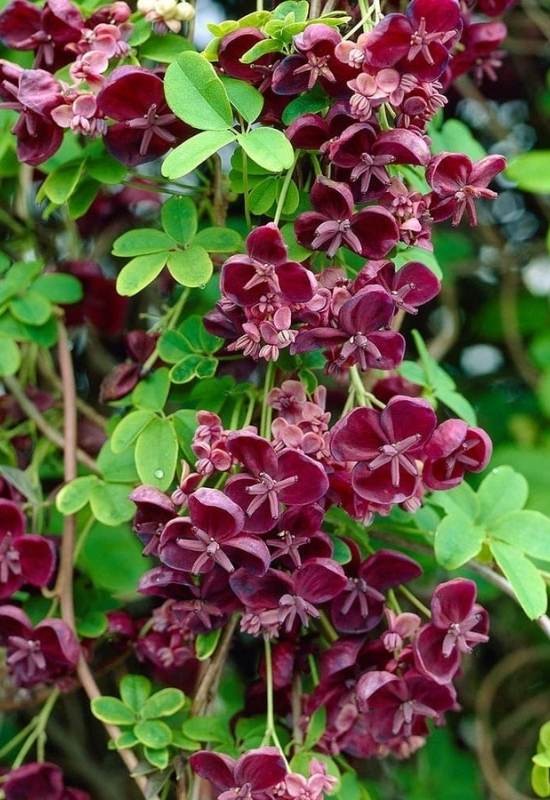
You can easily grow chocolate vine as ground cover; you just need to let it sprawl on the land instead of making it climb.
It may appear as a strange solution, but it is very common. And you get a lot of advantages. To start with you can cover a wide area with just one plant. Secondly, you get mulberry purple blooms with a very exotic look on top of the rare color.
The fleshy blooms in fact look like nodding open capsules. And yes, they do have a spicy cocoa fragrance too.
They are followed by edible sausage shaped violet pods, that stand out clearly against the bright green ovate foliage.
However, as the cold season approaches, even this will turn purple! It may stay on in winter in warmer climates, as it is a semi evergreen.
Chocolate vine has won the Award of Garden Merit by the Royal Horticultural Society and it is ideal for large areas even in the shade, like under trees, where very few plants can grow.
10. ‘Sweet Heidy’ Cranesbill (Geranium ‘Sweet Heidy’)
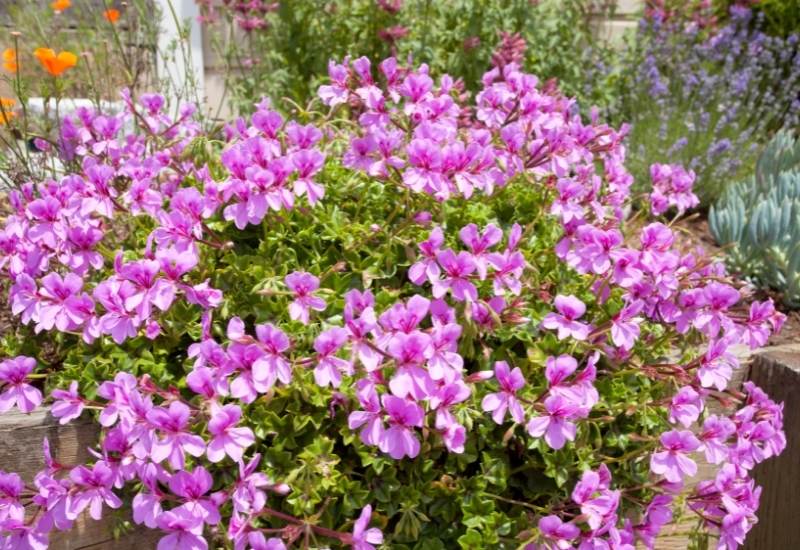
Cranesbills are perfect ground cover plants for all sunlight conditions and the one with some of the best purple flowers of this species is ‘Sweet Heidy’.
They have a very vibrant shade of amethyst that fades as you get towards the center of the bloom.
You will also see beautiful jam colored veins that radiate from the middle, like Sun rays. And the dark wine purple pistils complete the effect.
It is a spreading perennial with finely textured and deeply cut foliage in the mid green range. This is thick and ideal for our purpose.
‘Sweet Heidy’ cranesbill is perfect under trees and shrubs, to protect the soil and add a layer of interest in shady places, but you can also grow it in all other sunlight situations, as long as your garden is informal.
11. Purple Rock Cress (Aubrieta deltoidea)
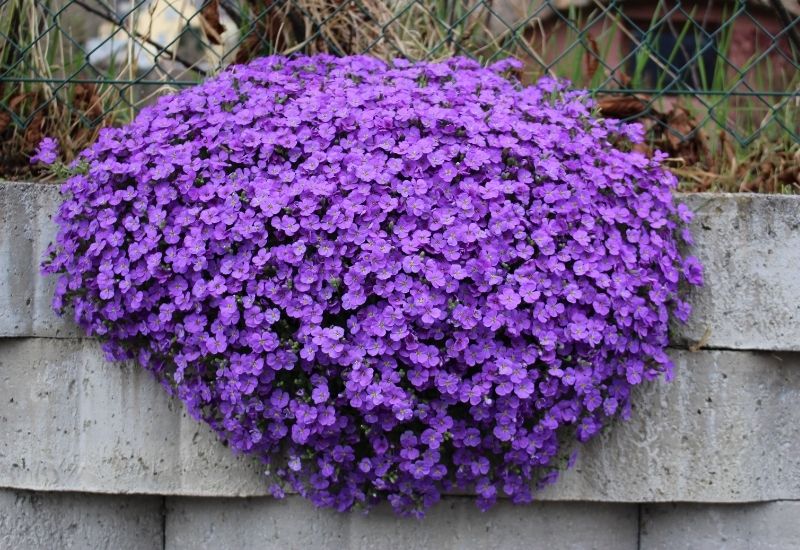
For a ground cover plant with very sweet looking flowers look at rock cress. The blooms have a perfect pure purple shade, with a bright yellow dot at the very center.
They have a vary round and full shape, which gives them a very gentle appearance. And this little generous perennial is very generous indeed; for months on end it will burst into this amazing color fully covering the foliage with its blossom.
The leaves are small, elliptical and dense, of a bright mid green shade. They may last all through the winters season as long as it does not get too cold because it is a semi evergreen.
Rock cress is perfect for stepping stones, crevices and rock gardens; I would think it’s better suited for small areas, but you could try it for larger spaces as well, or mix it with other ground cover plants.
12. Winter Blooming Bergenia (Bergebia crassifolia)
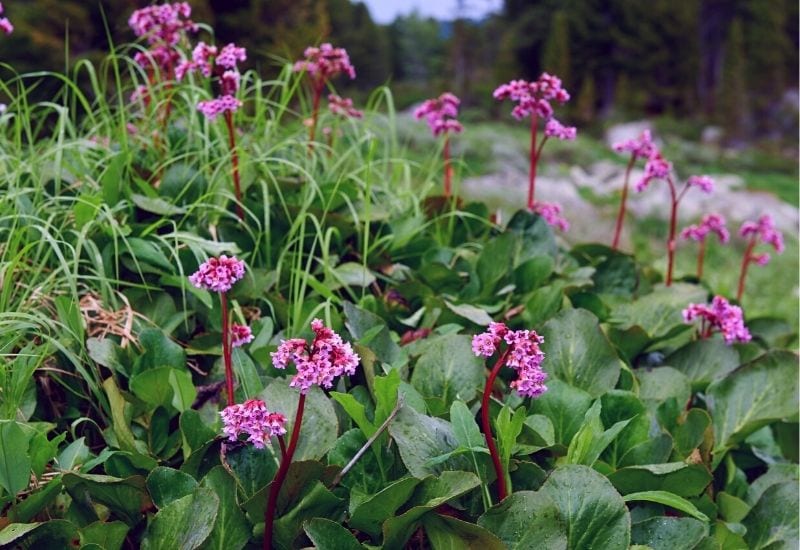
Also known as elephant’s ears, winter blooming bergenia is a classic of ground cover plants. Not all species have purple flowers, but Bergenia crassifolia does.
They are bright lilac and they come in elegant branching inflorescences called “cymes” on top of long stems that hover above the foliage. Each cluster is made up of dozens of flowers.
Then you have the evergreen leaves, which are famous for their almost succulent fleshiness, bright green and glossy color and large, round shape, reaching 8 inches (20 cm) in length.
The foliage will form a thick and decorative carpet on the floor, keeping the soil moist and housing many beneficial small animals.
Winter blooming bergenia is better suited for a garden in cold climates, as it does not tolerate the heat; on the other hand, it can grow well even in heavy shade. Good for medium size solutions, and popular under trees.
13. Woolly Thyme (Thymus pseudolanguinosus)
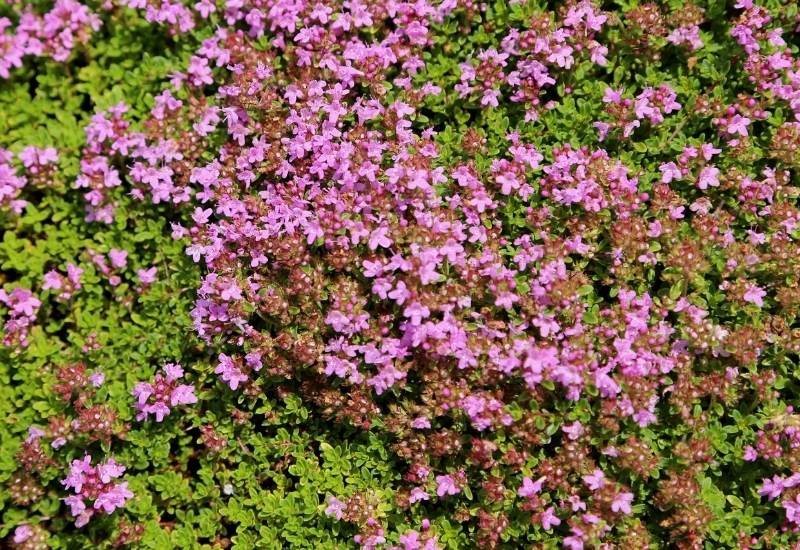
Woolly thyme is a low growing shrub with pale mauve flowers mainly used as ground cover. The blooms come in summer and they are fairly dense, but not as much as in other thyme varieties or in heather. But its still attracts lots of butterflies.
However, there is more to say about this plant… It forms a very thick mesh of prostrate branches, purple in color covered with the mist amazing soft foliage. In fact, the mid green leaves are packed together very tightly and they have a dense fluff on them. So, overall, you get the effect of a natural carpet, and you will have this all year round, because it is evergreen.
Woolly thyme is perfect if you want a soft looking effect in your garden; as it is very small, it is also excellent between stepping stones.
14. Magenta Rock Rose (Cistus x pulverulentus ‘Sunset’)
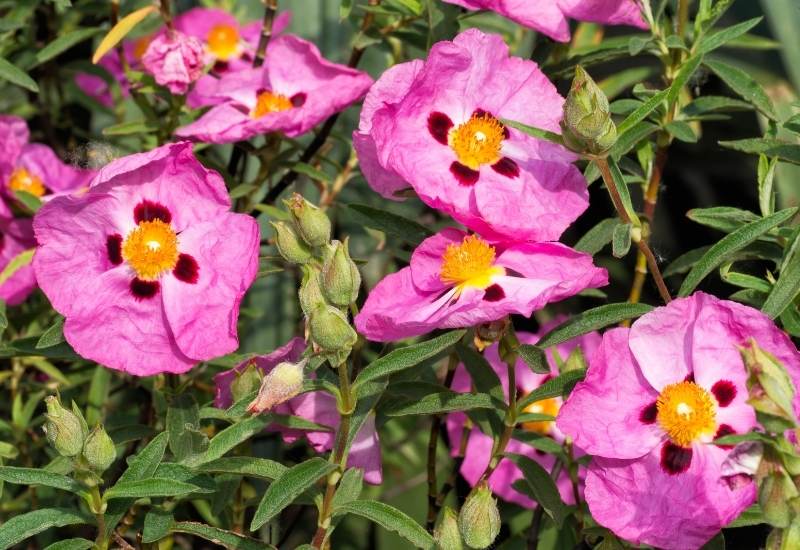
Magenta rock rose ‘Sunset’ is a prize winning ground cover perennial low shrub for sunny gardens. The color of the blooms is very bright, full and vibrant and with a golden center that heightens the luminosity of the flowers. Each head can reach 2 inches across, quite big for this type of plants.
It will keep blossoming for months on end too! The leaves are pointed and veined, slightly fuzzy and of a soothing shade of mid green. It is also a winner of the Award of Garden Merit by the Royal Horticultural Society.
Equally suitable for ground cover or flower beds, magenta rock rose is the ideal choice if you want to bring lots of energy to your garden while covering and protecting your land.
15. Persian Violet (Cyclamen coum)
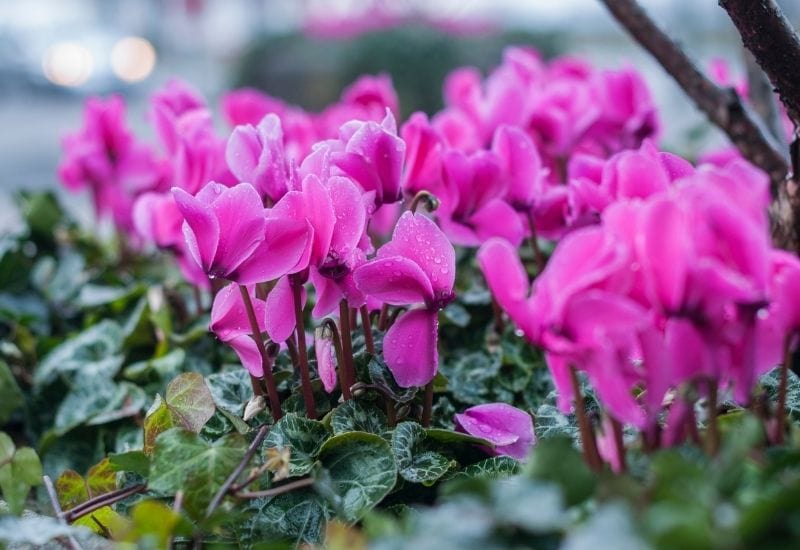
Persian violet is the most typical cyclamen of temperate regions, and as ground cover it is exceptional. In fact, it can even grow under pine trees and other conifers. The flowers with reflexed petals are typical of this famous plant, and in our variety, they are of a rosy purple shade, very typical indeed. It is not a large variety, but it is also fairly cold hardy.
The leaves are heart shaped, glossy, dark green and with lighter silver dots on them.
They form lovely clumps under trees and shrubs, and they come back year after year because they naturalize easily if the soil is good. It is also a winner of the Award of Garden Merit by the Royal Horticultural Society.
Persian violet brings to mind woods and forests, and this is where it will look best in your garden too. It will not tolerate full Sun, and it is easier to grow it for medium sized solutions, though in Nature you can find large areas filled with these amazing flowers.
Drape Your Garden in Purple with Ground Cover Plants
If purple is your choice of color to spread a green blanket over the bare soil in your garden, then you can choose one or more of the ground cover plants in this article, and there is one for every condition of light and even climate.

Written By
Amber Noyes
Amber Noyes was born and raised in a suburban California town, San Mateo. She holds a master’s degree in horticulture from the University of California as well as a BS in Biology from the University of San Francisco. With experience working on an organic farm, water conservation research, farmers’ markets, and plant nursery, she understands what makes plants thrive and how we can better understand the connection between microclimate and plant health. When she’s not on the land, Amber loves informing people of new ideas/things related to gardening, especially organic gardening, houseplants, and growing plants in a small space.

Good Afternoon